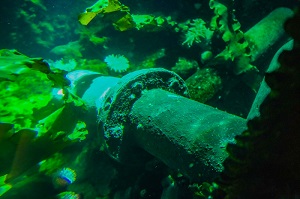Stronger Storms Test Aging U.S. Offshore Oil Facilities
HOUSTON (Reuters) — Stronger hurricanes threatening the U.S. Gulf Coast energy hub are elevating the risks of oil spills from damage to area refineries, oil platforms and subsea pipelines, experts say.

On Monday, the U.S. Coast Guard said it was investigating nearly 350 reports of spills in and along the Gulf after Hurricane Ida hit. Federal and state agencies were forming a task force to track leaks and address storm damages.
Underwater oil leaks caused by the storm off the coast of Louisiana highlight the dangers from aging and idled energy infrastructure.
"Extreme weather and hurricanes do not mix with offshore drilling," said Sarah Giltz, a marine scientist with advocacy group Oceana. "Hurricane-caused damage to oil and gas infrastructure is a leading cause of oil spills."
The U.S. offshore regulator lacks a sufficiently robust oversight process for ensuring security of offshore pipelines, according to a March study by the U.S. Government Accountability Office (GAO). The report added that the Bureau of Safety and Environmental Enforcement (BSEE) also does not properly address risks from idled infrastructure on the seafloor.
"If pipelines decommissioned-in-place are later found to pose risks, there is no funding source for removal," GAO said in its report to Congress.
WEAK OVERSIGHT
Many production platforms installed in the 1960s and 1970s became uneconomic and were removed during the 1990s. Decommissioned wells must be plugged and structures severed 15 feet below the mud line within a year of lease termination.
But the offshore regulator "does not have a robust oversight process" over pipelines, platform decommissioning nor undersea leaks, the study said. BSEE has proposed to update the regulations, but little progress has been achieved so far, it added.
"This has contributed to BSEE and its predecessors authorizing industry to leave over 97% of all decommissioned pipelines on the Gulf's seafloor since the 1960s," the report said.
FINANCIAL ASSURANCE
U.S. energy officials have sought to expand the industry's responsibility for removing idled infrastructure, especially after corporate bankruptcies. Regulators need to demand higher insurance bonds from producers, officials said.
"We want to make sure that companies are financially strong and taxpayers are not loaded with these costs," Walter Cruickshank, deputy director of the Bureau of Ocean Energy Management, said last month.
This week, offshore producer Talos Energy was directing the cleanup of a leak near a former drilling site. The company said its pipelines had been removed and the leak was from lines that other companies had abandoned.
"It was important to mobilize and identify the source and to contain the release to reduce safety and environmental risks," said John Spath, a Talos senior vice president. "We will continue working with local, state and federal regulators to see this through."
AGING PIPES
Energy companies have built 40,000 miles of oil and gas pipelines in federal offshore waters since the 1940s. Since the first well was drilled in 1942, about 6,000 structures also have been installed in the U.S. side of the Gulf of Mexico, ranging from shallow-water platforms to complex deepwater facilities.
Of those, some 3,500 structures currently stand, with over 3,200 active and some 200 inactive, according to the National Oceanic and Atmospheric Administration (NOAA).
As of April 2019, there were 1,862 oil and gas platforms in the Gulf interconnected by hundreds of miles of pipelines, BSEE data showed.
"As pipelines age, they are more susceptible to damage from corrosion, mudslides and seafloor erosion," GAO said. "Additionally, hurricanes can move pipeline extensive distances.”
Related News
Related News

- Enbridge Plans 86-Mile Pipeline Expansion, Bringing 850 Workers to Northern B.C.
- Intensity, Rainbow Energy to Build 344-Mile Gas Pipeline Across North Dakota
- Strike Pioneers First-of-Its-Kind Pipe-in-Pipe Installation on Gulf Coast with Enbridge
- 208-Mile Mississippi-to-Alabama Gas Pipeline Moves Into FERC Review
- Court Ruling Allows MVP’s $500 Million Southgate Pipeline Extension to Proceed
- U.S. Pipeline Expansion to Add 99 Bcf/d, Mostly for LNG Export, Report Finds
- A Systematic Approach To Ensuring Pipeline Integrity
- 275-Mile Texas-to-Oklahoma Gas Pipeline Enters Open Season
- LNG Canada Start-Up Fails to Lift Gas Prices Amid Supply Glut
- Strike Pioneers First-of-Its-Kind Pipe-in-Pipe Installation on Gulf Coast with Enbridge




Comments